Company Accounting Report: Financial Statement Analysis of CBA 2017
VerifiedAdded on 2023/06/06
|9
|1587
|349
Report
AI Summary
This report analyzes the financial statements of the Commonwealth Bank of Australia (CBA) for the year 2017, focusing on key accounting treatments and disclosures. It examines income tax expenses, deferred tax assets and liabilities, and the translation of foreign operations, including foreign currency risks and hedging strategies. Furthermore, the report discusses revaluation and impairment of assets, including intangible assets and properties, and analyzes the application of lease accounting standards, specifically IASB 17 and the upcoming AASB 16. The analysis includes calculations related to foreign currency trade and provides journal entries for asset revaluation. The report provides a comprehensive overview of significant financial reporting elements within CBA's 2017 annual report.
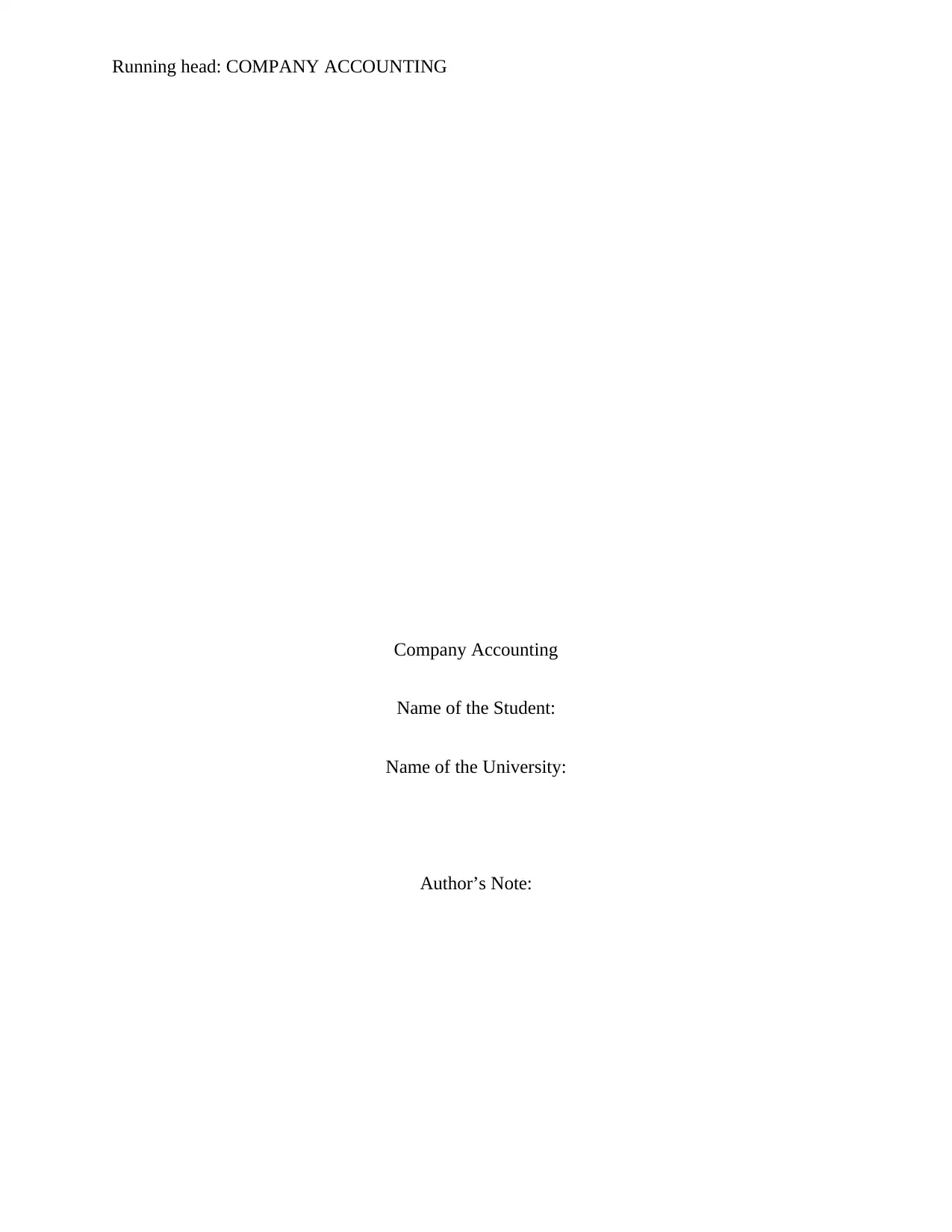
Running head: COMPANY ACCOUNTING
Company Accounting
Name of the Student:
Name of the University:
Author’s Note:
Company Accounting
Name of the Student:
Name of the University:
Author’s Note:
Paraphrase This Document
Need a fresh take? Get an instant paraphrase of this document with our AI Paraphraser

1
COMPANY ACCOUNTING
Table of Contents
Introduction......................................................................................................................................2
Discussion........................................................................................................................................2
Accounting for Taxation Expenses..............................................................................................2
Translation of Foreign Operations...............................................................................................3
Revaluation and Impairments......................................................................................................5
Accounting for Leases.................................................................................................................6
Reference.........................................................................................................................................8
COMPANY ACCOUNTING
Table of Contents
Introduction......................................................................................................................................2
Discussion........................................................................................................................................2
Accounting for Taxation Expenses..............................................................................................2
Translation of Foreign Operations...............................................................................................3
Revaluation and Impairments......................................................................................................5
Accounting for Leases.................................................................................................................6
Reference.........................................................................................................................................8
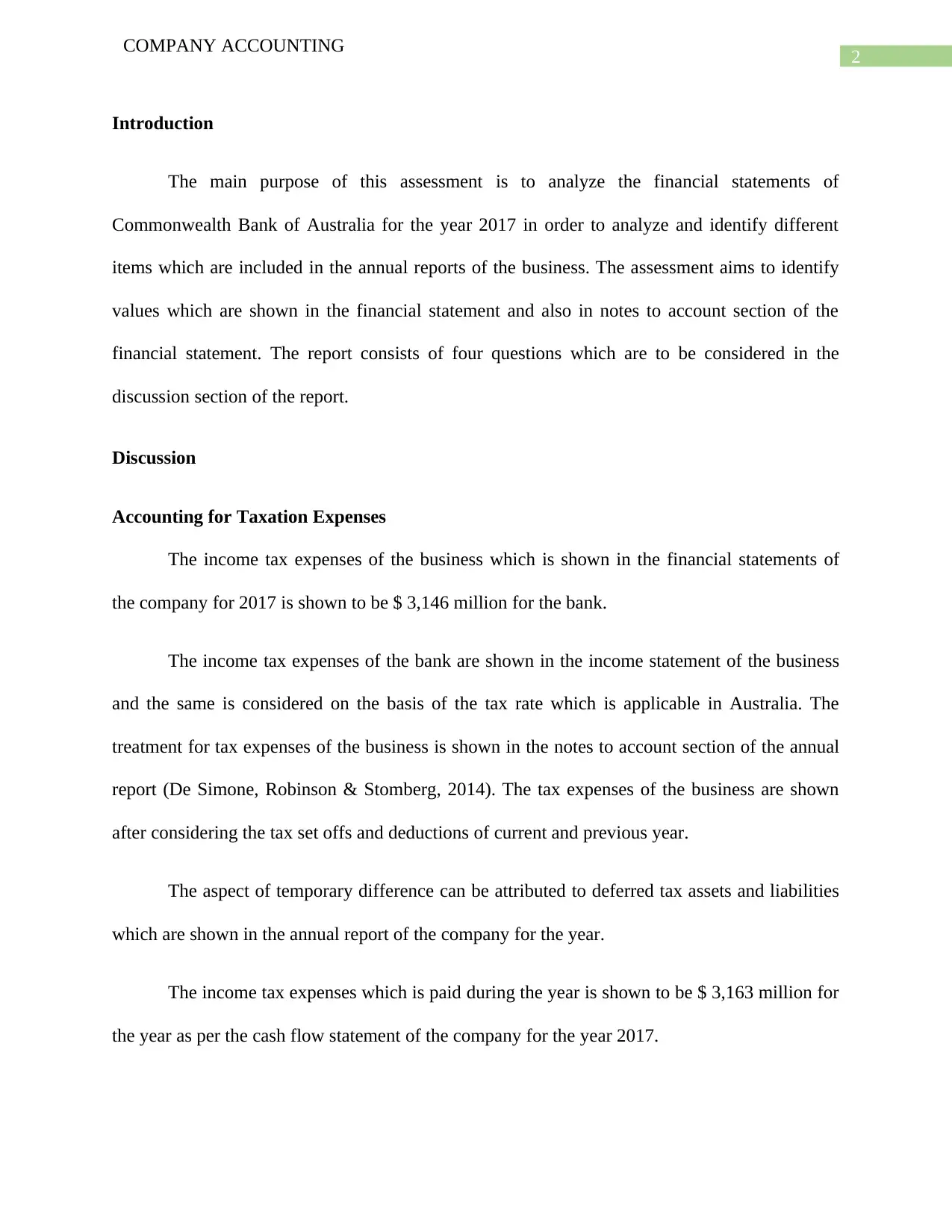
2
COMPANY ACCOUNTING
Introduction
The main purpose of this assessment is to analyze the financial statements of
Commonwealth Bank of Australia for the year 2017 in order to analyze and identify different
items which are included in the annual reports of the business. The assessment aims to identify
values which are shown in the financial statement and also in notes to account section of the
financial statement. The report consists of four questions which are to be considered in the
discussion section of the report.
Discussion
Accounting for Taxation Expenses
The income tax expenses of the business which is shown in the financial statements of
the company for 2017 is shown to be $ 3,146 million for the bank.
The income tax expenses of the bank are shown in the income statement of the business
and the same is considered on the basis of the tax rate which is applicable in Australia. The
treatment for tax expenses of the business is shown in the notes to account section of the annual
report (De Simone, Robinson & Stomberg, 2014). The tax expenses of the business are shown
after considering the tax set offs and deductions of current and previous year.
The aspect of temporary difference can be attributed to deferred tax assets and liabilities
which are shown in the annual report of the company for the year.
The income tax expenses which is paid during the year is shown to be $ 3,163 million for
the year as per the cash flow statement of the company for the year 2017.
COMPANY ACCOUNTING
Introduction
The main purpose of this assessment is to analyze the financial statements of
Commonwealth Bank of Australia for the year 2017 in order to analyze and identify different
items which are included in the annual reports of the business. The assessment aims to identify
values which are shown in the financial statement and also in notes to account section of the
financial statement. The report consists of four questions which are to be considered in the
discussion section of the report.
Discussion
Accounting for Taxation Expenses
The income tax expenses of the business which is shown in the financial statements of
the company for 2017 is shown to be $ 3,146 million for the bank.
The income tax expenses of the bank are shown in the income statement of the business
and the same is considered on the basis of the tax rate which is applicable in Australia. The
treatment for tax expenses of the business is shown in the notes to account section of the annual
report (De Simone, Robinson & Stomberg, 2014). The tax expenses of the business are shown
after considering the tax set offs and deductions of current and previous year.
The aspect of temporary difference can be attributed to deferred tax assets and liabilities
which are shown in the annual report of the company for the year.
The income tax expenses which is paid during the year is shown to be $ 3,163 million for
the year as per the cash flow statement of the company for the year 2017.
⊘ This is a preview!⊘
Do you want full access?
Subscribe today to unlock all pages.

Trusted by 1+ million students worldwide
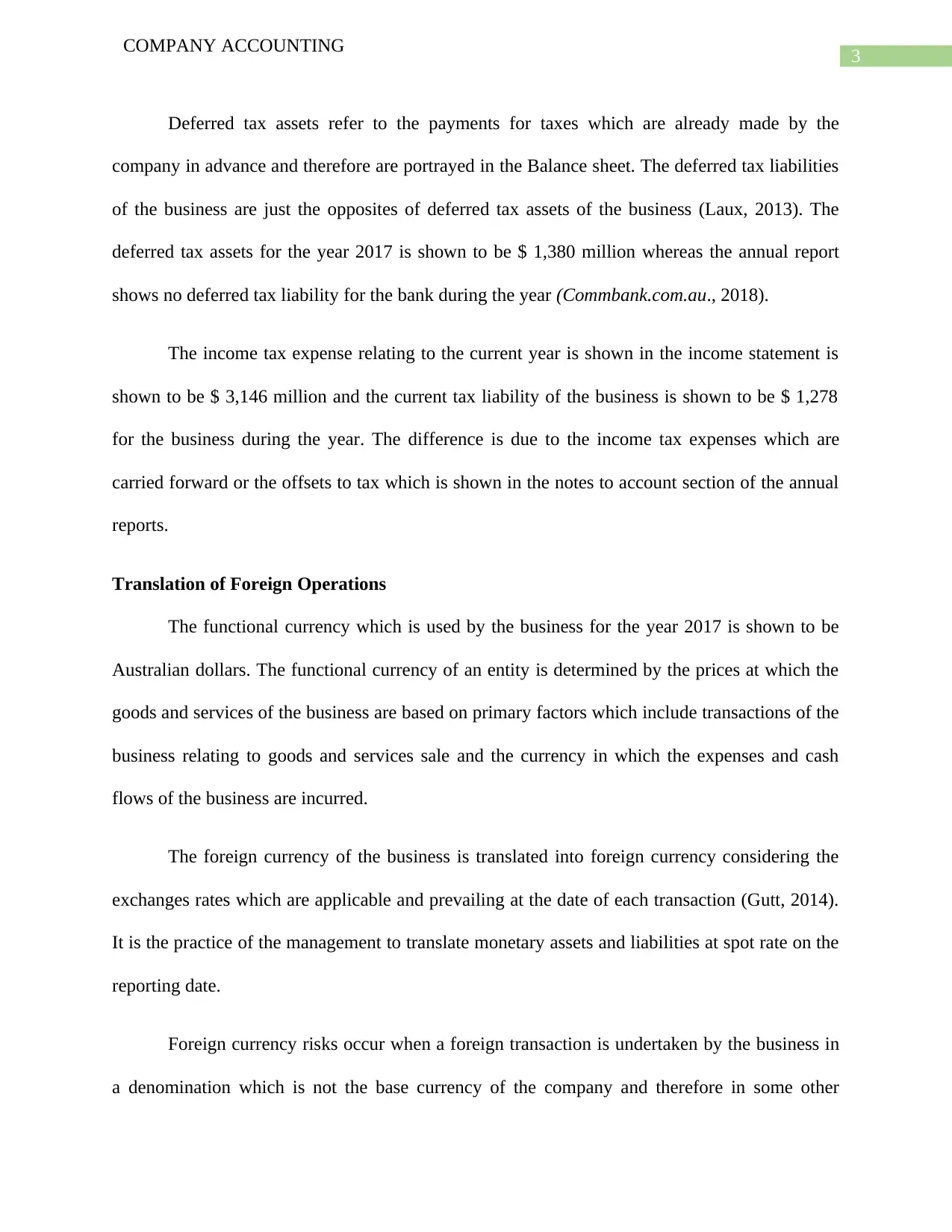
3
COMPANY ACCOUNTING
Deferred tax assets refer to the payments for taxes which are already made by the
company in advance and therefore are portrayed in the Balance sheet. The deferred tax liabilities
of the business are just the opposites of deferred tax assets of the business (Laux, 2013). The
deferred tax assets for the year 2017 is shown to be $ 1,380 million whereas the annual report
shows no deferred tax liability for the bank during the year (Commbank.com.au., 2018).
The income tax expense relating to the current year is shown in the income statement is
shown to be $ 3,146 million and the current tax liability of the business is shown to be $ 1,278
for the business during the year. The difference is due to the income tax expenses which are
carried forward or the offsets to tax which is shown in the notes to account section of the annual
reports.
Translation of Foreign Operations
The functional currency which is used by the business for the year 2017 is shown to be
Australian dollars. The functional currency of an entity is determined by the prices at which the
goods and services of the business are based on primary factors which include transactions of the
business relating to goods and services sale and the currency in which the expenses and cash
flows of the business are incurred.
The foreign currency of the business is translated into foreign currency considering the
exchanges rates which are applicable and prevailing at the date of each transaction (Gutt, 2014).
It is the practice of the management to translate monetary assets and liabilities at spot rate on the
reporting date.
Foreign currency risks occur when a foreign transaction is undertaken by the business in
a denomination which is not the base currency of the company and therefore in some other
COMPANY ACCOUNTING
Deferred tax assets refer to the payments for taxes which are already made by the
company in advance and therefore are portrayed in the Balance sheet. The deferred tax liabilities
of the business are just the opposites of deferred tax assets of the business (Laux, 2013). The
deferred tax assets for the year 2017 is shown to be $ 1,380 million whereas the annual report
shows no deferred tax liability for the bank during the year (Commbank.com.au., 2018).
The income tax expense relating to the current year is shown in the income statement is
shown to be $ 3,146 million and the current tax liability of the business is shown to be $ 1,278
for the business during the year. The difference is due to the income tax expenses which are
carried forward or the offsets to tax which is shown in the notes to account section of the annual
reports.
Translation of Foreign Operations
The functional currency which is used by the business for the year 2017 is shown to be
Australian dollars. The functional currency of an entity is determined by the prices at which the
goods and services of the business are based on primary factors which include transactions of the
business relating to goods and services sale and the currency in which the expenses and cash
flows of the business are incurred.
The foreign currency of the business is translated into foreign currency considering the
exchanges rates which are applicable and prevailing at the date of each transaction (Gutt, 2014).
It is the practice of the management to translate monetary assets and liabilities at spot rate on the
reporting date.
Foreign currency risks occur when a foreign transaction is undertaken by the business in
a denomination which is not the base currency of the company and therefore in some other
Paraphrase This Document
Need a fresh take? Get an instant paraphrase of this document with our AI Paraphraser

4
COMPANY ACCOUNTING
currency. As per the annual report of the company, the management of the company invests in
hedge funds in order to minimize the risks which are related to foreign currency in a country
(Mudogo & Venkatraman, 2013).
The foreign currency translation reserve for 2017 is shown to be $ 35 million. The
components which are included in foreign currency translation reserve are current foreign
currency translations and hedge investments.
Accounting for Foreign Currency Trade
Particulars Amount Amount Exchange Rate Amount Amount
S$ S$ A$ A$
Sales Revenue 1,200,000 0.85 1,020,000
Cost of Sales:
Purchases 1,020,000 0.85 867,000
Ending Inventory 205,000 815,000 0.77 157,850 709,150
Gross Profit 385,000 310,850
Expenses:
Selling 120,000 0.85 102,000
Depreciation 10,000 0.85 8,500
Interest 20,000 0.85 17,000
Other 90,000 240,000 0.85 76,500 204,000
Profit before income tax 145,000 106,850
Income Tax Expense 60,000 0.85 51,000
Profit for the period 85,000 55,850
In the books of Onoyoko Ltd.
Income Statement
for the year ended 30th June 2018
COMPANY ACCOUNTING
currency. As per the annual report of the company, the management of the company invests in
hedge funds in order to minimize the risks which are related to foreign currency in a country
(Mudogo & Venkatraman, 2013).
The foreign currency translation reserve for 2017 is shown to be $ 35 million. The
components which are included in foreign currency translation reserve are current foreign
currency translations and hedge investments.
Accounting for Foreign Currency Trade
Particulars Amount Amount Exchange Rate Amount Amount
S$ S$ A$ A$
Sales Revenue 1,200,000 0.85 1,020,000
Cost of Sales:
Purchases 1,020,000 0.85 867,000
Ending Inventory 205,000 815,000 0.77 157,850 709,150
Gross Profit 385,000 310,850
Expenses:
Selling 120,000 0.85 102,000
Depreciation 10,000 0.85 8,500
Interest 20,000 0.85 17,000
Other 90,000 240,000 0.85 76,500 204,000
Profit before income tax 145,000 106,850
Income Tax Expense 60,000 0.85 51,000
Profit for the period 85,000 55,850
In the books of Onoyoko Ltd.
Income Statement
for the year ended 30th June 2018
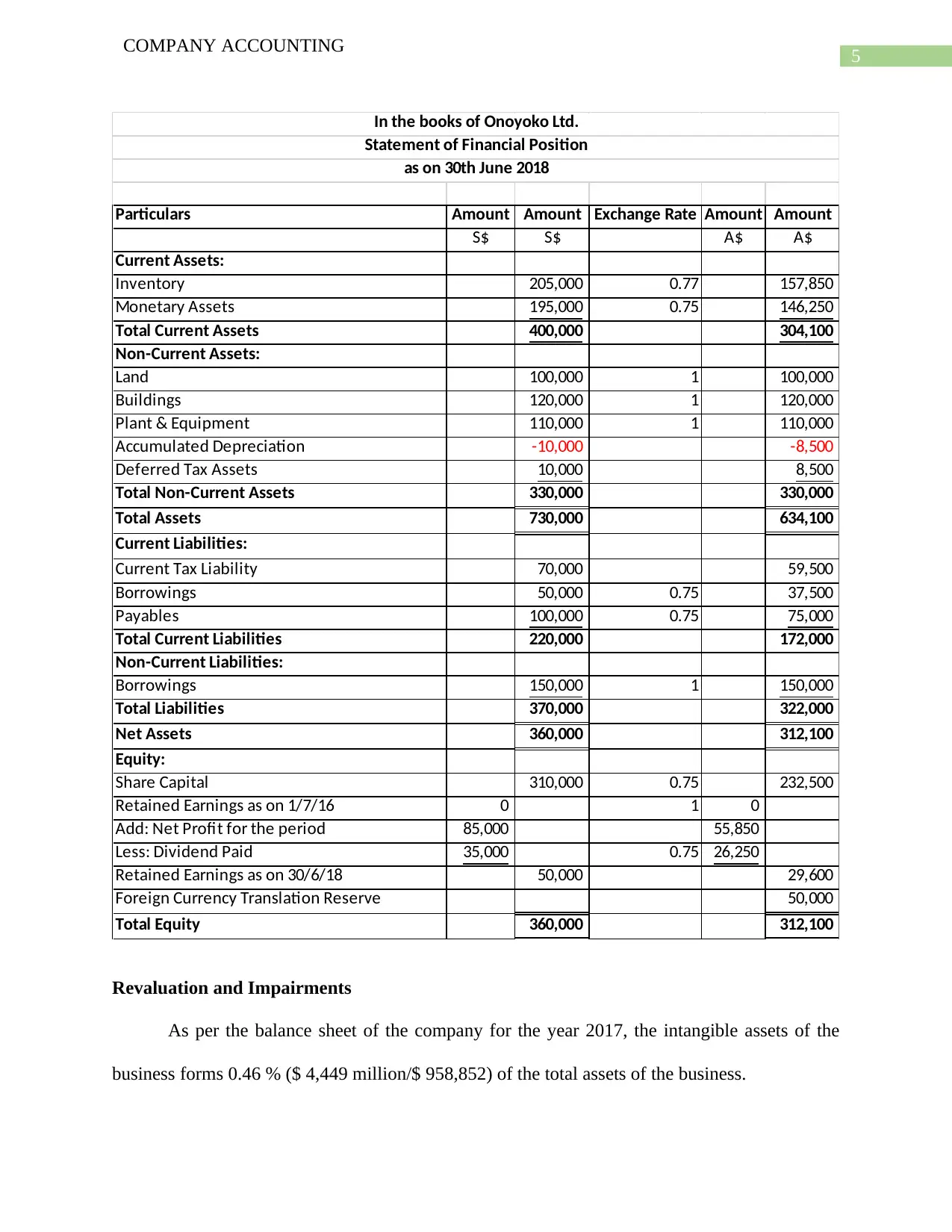
5
COMPANY ACCOUNTING
Particulars Amount Amount Exchange Rate Amount Amount
S$ S$ A$ A$
Current Assets:
Inventory 205,000 0.77 157,850
Monetary Assets 195,000 0.75 146,250
Total Current Assets 400,000 304,100
Non-Current Assets:
Land 100,000 1 100,000
Buildings 120,000 1 120,000
Plant & Equipment 110,000 1 110,000
Accumulated Depreciation -10,000 -8,500
Deferred Tax Assets 10,000 8,500
Total Non-Current Assets 330,000 330,000
Total Assets 730,000 634,100
Current Liabilities:
Current Tax Liability 70,000 59,500
Borrowings 50,000 0.75 37,500
Payables 100,000 0.75 75,000
Total Current Liabilities 220,000 172,000
Non-Current Liabilities:
Borrowings 150,000 1 150,000
Total Liabilities 370,000 322,000
Net Assets 360,000 312,100
Equity:
Share Capital 310,000 0.75 232,500
Retained Earnings as on 1/7/16 0 1 0
Add: Net Profit for the period 85,000 55,850
Less: Dividend Paid 35,000 0.75 26,250
Retained Earnings as on 30/6/18 50,000 29,600
Foreign Currency Translation Reserve 50,000
Total Equity 360,000 312,100
In the books of Onoyoko Ltd.
Statement of Financial Position
as on 30th June 2018
Revaluation and Impairments
As per the balance sheet of the company for the year 2017, the intangible assets of the
business forms 0.46 % ($ 4,449 million/$ 958,852) of the total assets of the business.
COMPANY ACCOUNTING
Particulars Amount Amount Exchange Rate Amount Amount
S$ S$ A$ A$
Current Assets:
Inventory 205,000 0.77 157,850
Monetary Assets 195,000 0.75 146,250
Total Current Assets 400,000 304,100
Non-Current Assets:
Land 100,000 1 100,000
Buildings 120,000 1 120,000
Plant & Equipment 110,000 1 110,000
Accumulated Depreciation -10,000 -8,500
Deferred Tax Assets 10,000 8,500
Total Non-Current Assets 330,000 330,000
Total Assets 730,000 634,100
Current Liabilities:
Current Tax Liability 70,000 59,500
Borrowings 50,000 0.75 37,500
Payables 100,000 0.75 75,000
Total Current Liabilities 220,000 172,000
Non-Current Liabilities:
Borrowings 150,000 1 150,000
Total Liabilities 370,000 322,000
Net Assets 360,000 312,100
Equity:
Share Capital 310,000 0.75 232,500
Retained Earnings as on 1/7/16 0 1 0
Add: Net Profit for the period 85,000 55,850
Less: Dividend Paid 35,000 0.75 26,250
Retained Earnings as on 30/6/18 50,000 29,600
Foreign Currency Translation Reserve 50,000
Total Equity 360,000 312,100
In the books of Onoyoko Ltd.
Statement of Financial Position
as on 30th June 2018
Revaluation and Impairments
As per the balance sheet of the company for the year 2017, the intangible assets of the
business forms 0.46 % ($ 4,449 million/$ 958,852) of the total assets of the business.
⊘ This is a preview!⊘
Do you want full access?
Subscribe today to unlock all pages.

Trusted by 1+ million students worldwide
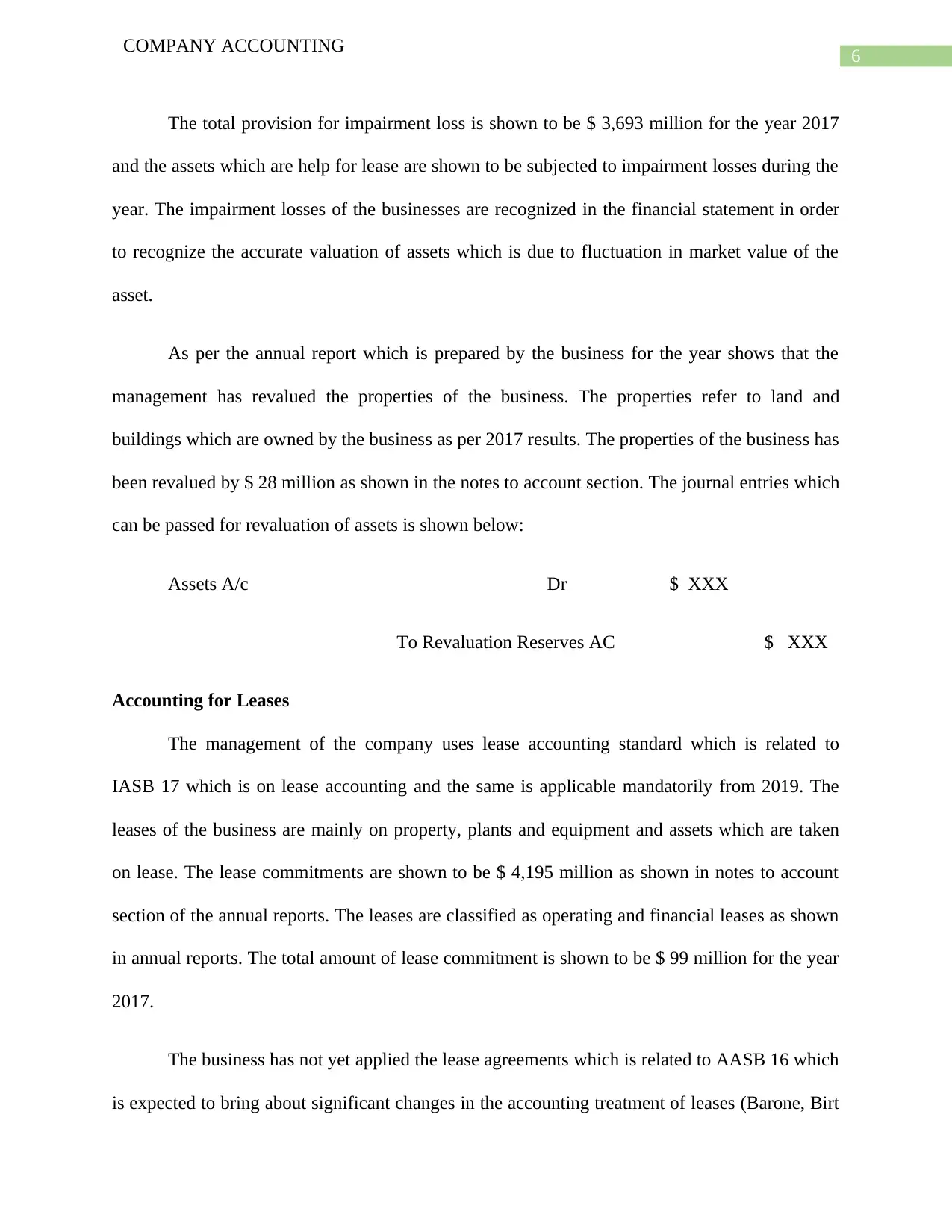
6
COMPANY ACCOUNTING
The total provision for impairment loss is shown to be $ 3,693 million for the year 2017
and the assets which are help for lease are shown to be subjected to impairment losses during the
year. The impairment losses of the businesses are recognized in the financial statement in order
to recognize the accurate valuation of assets which is due to fluctuation in market value of the
asset.
As per the annual report which is prepared by the business for the year shows that the
management has revalued the properties of the business. The properties refer to land and
buildings which are owned by the business as per 2017 results. The properties of the business has
been revalued by $ 28 million as shown in the notes to account section. The journal entries which
can be passed for revaluation of assets is shown below:
Assets A/c Dr $ XXX
To Revaluation Reserves AC $ XXX
Accounting for Leases
The management of the company uses lease accounting standard which is related to
IASB 17 which is on lease accounting and the same is applicable mandatorily from 2019. The
leases of the business are mainly on property, plants and equipment and assets which are taken
on lease. The lease commitments are shown to be $ 4,195 million as shown in notes to account
section of the annual reports. The leases are classified as operating and financial leases as shown
in annual reports. The total amount of lease commitment is shown to be $ 99 million for the year
2017.
The business has not yet applied the lease agreements which is related to AASB 16 which
is expected to bring about significant changes in the accounting treatment of leases (Barone, Birt
COMPANY ACCOUNTING
The total provision for impairment loss is shown to be $ 3,693 million for the year 2017
and the assets which are help for lease are shown to be subjected to impairment losses during the
year. The impairment losses of the businesses are recognized in the financial statement in order
to recognize the accurate valuation of assets which is due to fluctuation in market value of the
asset.
As per the annual report which is prepared by the business for the year shows that the
management has revalued the properties of the business. The properties refer to land and
buildings which are owned by the business as per 2017 results. The properties of the business has
been revalued by $ 28 million as shown in the notes to account section. The journal entries which
can be passed for revaluation of assets is shown below:
Assets A/c Dr $ XXX
To Revaluation Reserves AC $ XXX
Accounting for Leases
The management of the company uses lease accounting standard which is related to
IASB 17 which is on lease accounting and the same is applicable mandatorily from 2019. The
leases of the business are mainly on property, plants and equipment and assets which are taken
on lease. The lease commitments are shown to be $ 4,195 million as shown in notes to account
section of the annual reports. The leases are classified as operating and financial leases as shown
in annual reports. The total amount of lease commitment is shown to be $ 99 million for the year
2017.
The business has not yet applied the lease agreements which is related to AASB 16 which
is expected to bring about significant changes in the accounting treatment of leases (Barone, Birt
Paraphrase This Document
Need a fresh take? Get an instant paraphrase of this document with our AI Paraphraser
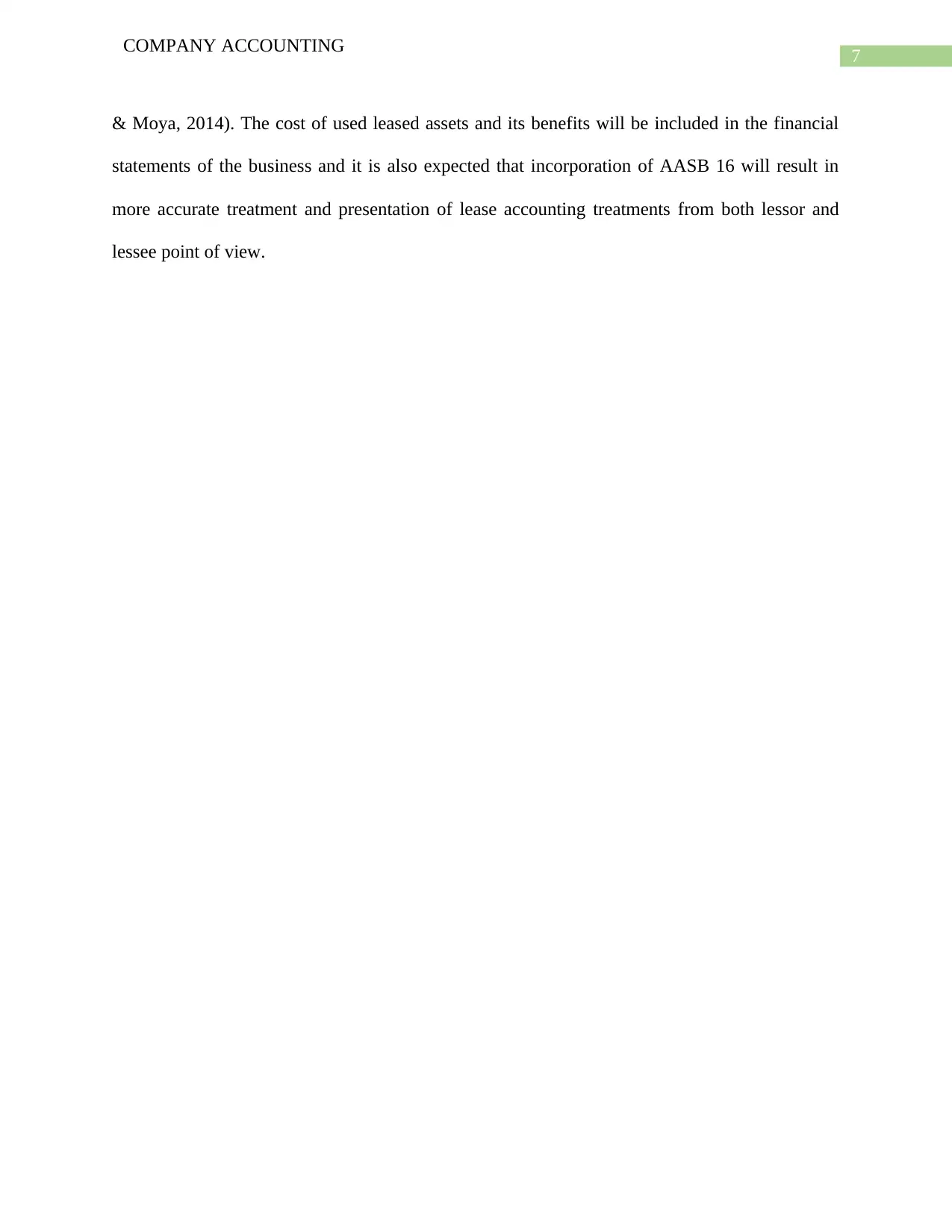
7
COMPANY ACCOUNTING
& Moya, 2014). The cost of used leased assets and its benefits will be included in the financial
statements of the business and it is also expected that incorporation of AASB 16 will result in
more accurate treatment and presentation of lease accounting treatments from both lessor and
lessee point of view.
COMPANY ACCOUNTING
& Moya, 2014). The cost of used leased assets and its benefits will be included in the financial
statements of the business and it is also expected that incorporation of AASB 16 will result in
more accurate treatment and presentation of lease accounting treatments from both lessor and
lessee point of view.
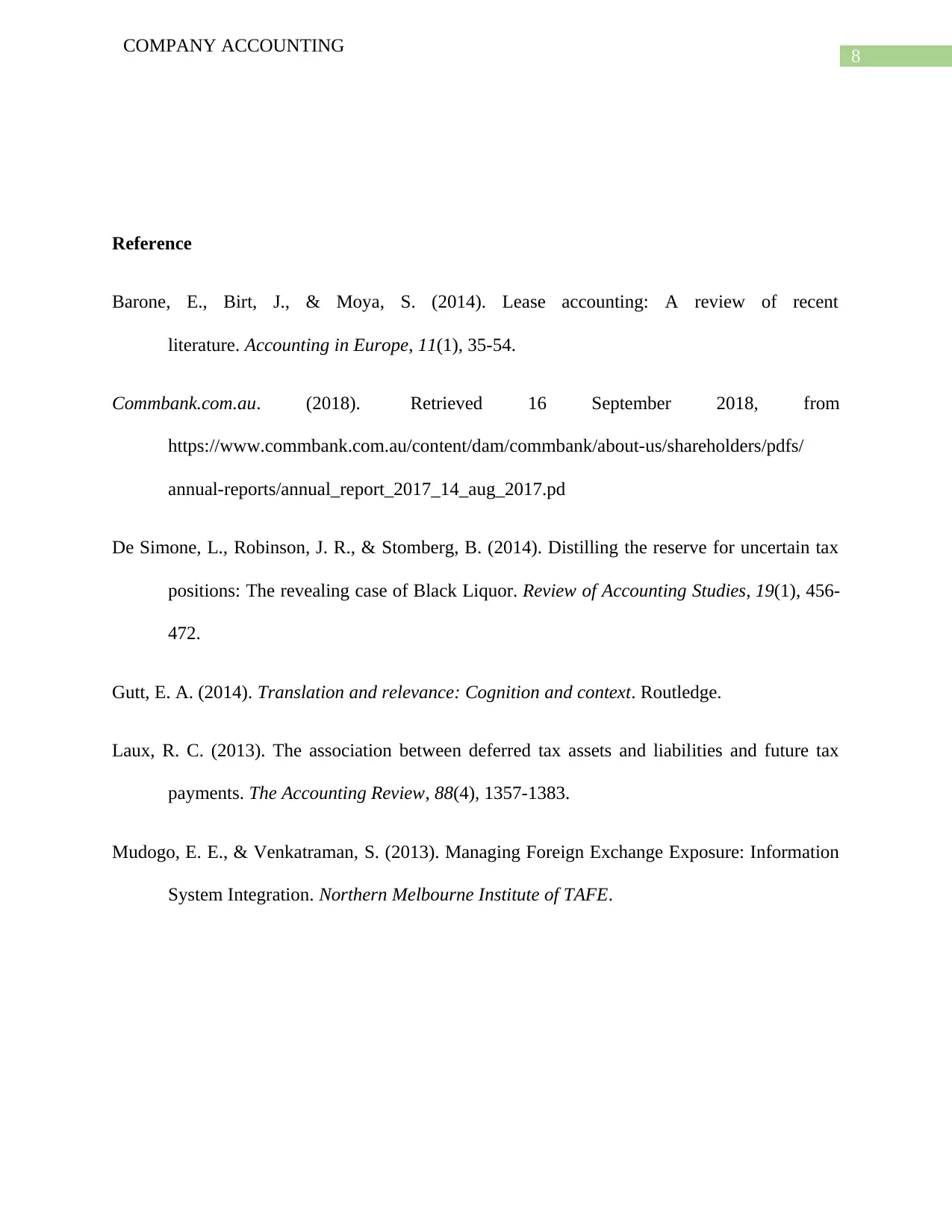
8
COMPANY ACCOUNTING
Reference
Barone, E., Birt, J., & Moya, S. (2014). Lease accounting: A review of recent
literature. Accounting in Europe, 11(1), 35-54.
Commbank.com.au. (2018). Retrieved 16 September 2018, from
https://www.commbank.com.au/content/dam/commbank/about-us/shareholders/pdfs/
annual-reports/annual_report_2017_14_aug_2017.pd
De Simone, L., Robinson, J. R., & Stomberg, B. (2014). Distilling the reserve for uncertain tax
positions: The revealing case of Black Liquor. Review of Accounting Studies, 19(1), 456-
472.
Gutt, E. A. (2014). Translation and relevance: Cognition and context. Routledge.
Laux, R. C. (2013). The association between deferred tax assets and liabilities and future tax
payments. The Accounting Review, 88(4), 1357-1383.
Mudogo, E. E., & Venkatraman, S. (2013). Managing Foreign Exchange Exposure: Information
System Integration. Northern Melbourne Institute of TAFE.
COMPANY ACCOUNTING
Reference
Barone, E., Birt, J., & Moya, S. (2014). Lease accounting: A review of recent
literature. Accounting in Europe, 11(1), 35-54.
Commbank.com.au. (2018). Retrieved 16 September 2018, from
https://www.commbank.com.au/content/dam/commbank/about-us/shareholders/pdfs/
annual-reports/annual_report_2017_14_aug_2017.pd
De Simone, L., Robinson, J. R., & Stomberg, B. (2014). Distilling the reserve for uncertain tax
positions: The revealing case of Black Liquor. Review of Accounting Studies, 19(1), 456-
472.
Gutt, E. A. (2014). Translation and relevance: Cognition and context. Routledge.
Laux, R. C. (2013). The association between deferred tax assets and liabilities and future tax
payments. The Accounting Review, 88(4), 1357-1383.
Mudogo, E. E., & Venkatraman, S. (2013). Managing Foreign Exchange Exposure: Information
System Integration. Northern Melbourne Institute of TAFE.
⊘ This is a preview!⊘
Do you want full access?
Subscribe today to unlock all pages.

Trusted by 1+ million students worldwide
1 out of 9
Related Documents
Your All-in-One AI-Powered Toolkit for Academic Success.
+13062052269
info@desklib.com
Available 24*7 on WhatsApp / Email
![[object Object]](/_next/static/media/star-bottom.7253800d.svg)
Unlock your academic potential
Copyright © 2020–2025 A2Z Services. All Rights Reserved. Developed and managed by ZUCOL.



